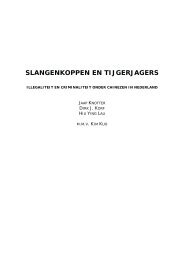Create successful ePaper yourself
Turn your PDF publications into a flip-book with our unique Google optimized e-Paper software.
SUMMARY, CONCLUSIONS & RECOMMENDATIONS<br />
Background<br />
‘Pill testing’ was introduced in the Netherlands at a very early stage, shortly after ecstasy<br />
began to spread. It was seen as an intervention to reduce the risks of ecstasy<br />
use. Testing was initially performed on a limited scale, mainly on-site at large dance<br />
events. Fairly soon thereafter, in 1992, the Drugs Information and Monitoring System<br />
(DIMS) was created at the national level. Among the tasks of this agency – which is<br />
part of the Netherlands Institute of Mental Health and Addiction (Trimbos Institute) in<br />
Utrecht – are the coordination of pill testing at the various testing sites throughout the<br />
country and the nationwide ‘monitoring’ and ‘surveillance’ of illicit drug markets. Testing<br />
ecstasy pills enables experts to follow developments in the ecstasy market (monitoring)<br />
and to launch warning campaigns in the event that hazardous pill types come<br />
to light (surveillance). The purpose of pill testing, then as now, has not been just to<br />
assess the content (quality and quantity of the ingredients) of pills sold as ecstasy,<br />
but also – and in the view of some, primarily – to educate people about drugs.<br />
Pill testing at raves and other events was discontinued in 1999. Currently pill testing<br />
is carried out exclusively ‘in the office’. 41 Even though the number of offices where<br />
pills can be tested has been significantly expanded, the number of pills tested has<br />
declined in recent years. That increasingly hampers the ability of DIMS to monitor<br />
trends in the ecstasy market, and this reduced ‘visibility’ has prompted a search for<br />
new ways to improve the monitoring of party drugs. Theoretically, mobile testing facilities<br />
located at places where drug use actually occurs, like dance parties and clubs,<br />
could be employed for this purpose.<br />
On 29 January 2002, the Lower Chamber of the Dutch Parliament passed a motion<br />
(24 007, no. 98) asking the government to reject any resumption of pill testing at<br />
dance events. Before coming to a final decision on carrying out the motion, the Cabi-<br />
net decided to commission a systematic study to compare the pill testing done at the<br />
currently existing locations with other procedures that could potentially improve the<br />
monitoring of party drugs.<br />
41 The offices also test ecstasy in other forms, such as powder, as well as other drugs, but these fall outside the<br />
scope of this report.<br />
85












